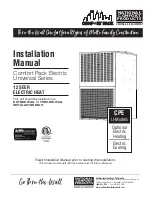
5
Using a screwdriver to turn the Burnback Time adjustment
counter clockwise shortens the amount of time welding current
is applied to the wire, LENGTHENING the amount of wire
sticking out past the contact tip. Turning the burnback time
adjustment clockwise increases the amount of time welding
current is applied to the wire, SHORTENING the amount of
wire sticking out past the contact tip.
Higher amperages and aluminum wire require a shorter
burnback time. To set the burnback time, a good starting point
is to rotate the burnback time knob approximately 25% in the
clockwise direction. The burnback is set correctly when the
welding wire does not stick to the work piece and does not melt
to the contact tip.
7) On-Off Switch
This switch controls the input power to your welder. The On-
Off switch allows you to turn the welding machine off, leaving
all the settings intact, ready for your next use.
Turning the switch to the ON position will illuminate an
indicator lamp in the On-Off switch and activate the cooling
fan. If the indicator lamp is not lit when the On-Off switch is in
the ON position, check to make sure that the machine is
properly connected to an electrical outlet in good working order.
Also be sure to check the fuse at the rear of the welder.
8) Welding Mode Switch
The welding mode switch lets you select between MIG “seam”
welding and “continuous” welding, lift arc DC TIG welding,
and stick welding.
MIG Seam Welding
The most common welding mode is the “seam” welding mode.
When you depress the trigger, the machine will weld, when you
release the trigger, the machine stops.
MIG Continuous Welding
The continuous welding mode is selected when welding long
seams and it is desired not to keep the trigger on the welding
gun depressed. Depressing the trigger and releasing it will
activate the welding machine. The welding machine will
continue welding until the trigger is depressed and released
again. This is very similar to a “lock-on” trigger on a drill or a
grinder.
TIG Welding Mode
When the MTS 160 is in the TIG welding mode, it is possible to
perform DC lift arc TIG welding of steel and stainless steel
material. The optional TIG welding torch must be attached to
the central adapter block on the front panel of the welder.
Stick Welding Mode
When the MTS 160 is in the stick welding mode, it is possible
to perform DC stick welding. Plug the optional electrode holder
into the positive output receptacle on the front of the unit for
electrode-positive (reverse polarity) stick welding and plug the
ground cable into the negative output receptacle.
Plug the optional electrode holder into the negative output
receptacle on the front of the unit for electrode-negative
(straight polarity) stick welding and plug the ground cable into
the positive output receptacle.
9) Amperage Adjustment (TIG and Stick Welding Modes)
Wire Feed Rate (MIG Welding Mode)
This knob has two different functions depending on the welding
mode.
In the TIG and STICK welding mode, this adjusts the welding
amperage of the machine. The higher the amperage, the thicker
the material you can weld. Minimum is 5 amps, 5 is 80 amps
and max is 160 amps. Use the following chart as a rough guide
for setting the amperage for TIG welding steel based on the
thickness of the material you will be welding.
Tungsten
Welding Amp
Filler
Thickness
Diameter
Amperage Setting
Diameter
.030"
.040"
30-40
2
.035"
.050"
1/16"
45-55
3
.035"
.062" (1/16")
1/16"
55-65
4
1/16"
.093" (3/32")
1/16"
80-90
5
1/16"
.125" (1/8")
1/16"-3/32"
110-120
7
1/16"
.187" (3/16")*
3/32"
130-140
9
1/16"
.250" (1/4")*
3/32"-1/8"
150-160
max
3/32"
In the MIG welding mode, this knob adjusts the wire feed rate.
The wire feed rate is infinitely adjustable and controls the wire
speed. Minimum is the slowest and maximum is the fastest.
The wire feed rate will depend on the wire diameter and the
welding voltage. The wire speed setting is tuned into the proper
welding sound. A hissing, blowing sound with a ball of molten
wire forming at the end of the wire and then dropping off
indicates the wire feed rate is too slow. A loud cracking noise
with the wire pushing the nozzle away from the work indicates
the wire feed is too fast. The proper wire feed rate is obtained
when a steady buzzing noise is heard while welding.
10) Voltage Adjustment
This knob controls the welding voltage in the MIG welding
mode. It is infinitely adjustable. The higher the welding
voltage the thicker you will be able to weld. Your MTS 160 will
let you weld from 24-ga steel up to 5/16" in mild steel.
Summary of Contents for MTS 160
Page 21: ...21 Wiring Diagram MTS 160...
Page 22: ...Parts Breakdown MTS 160 22...






































